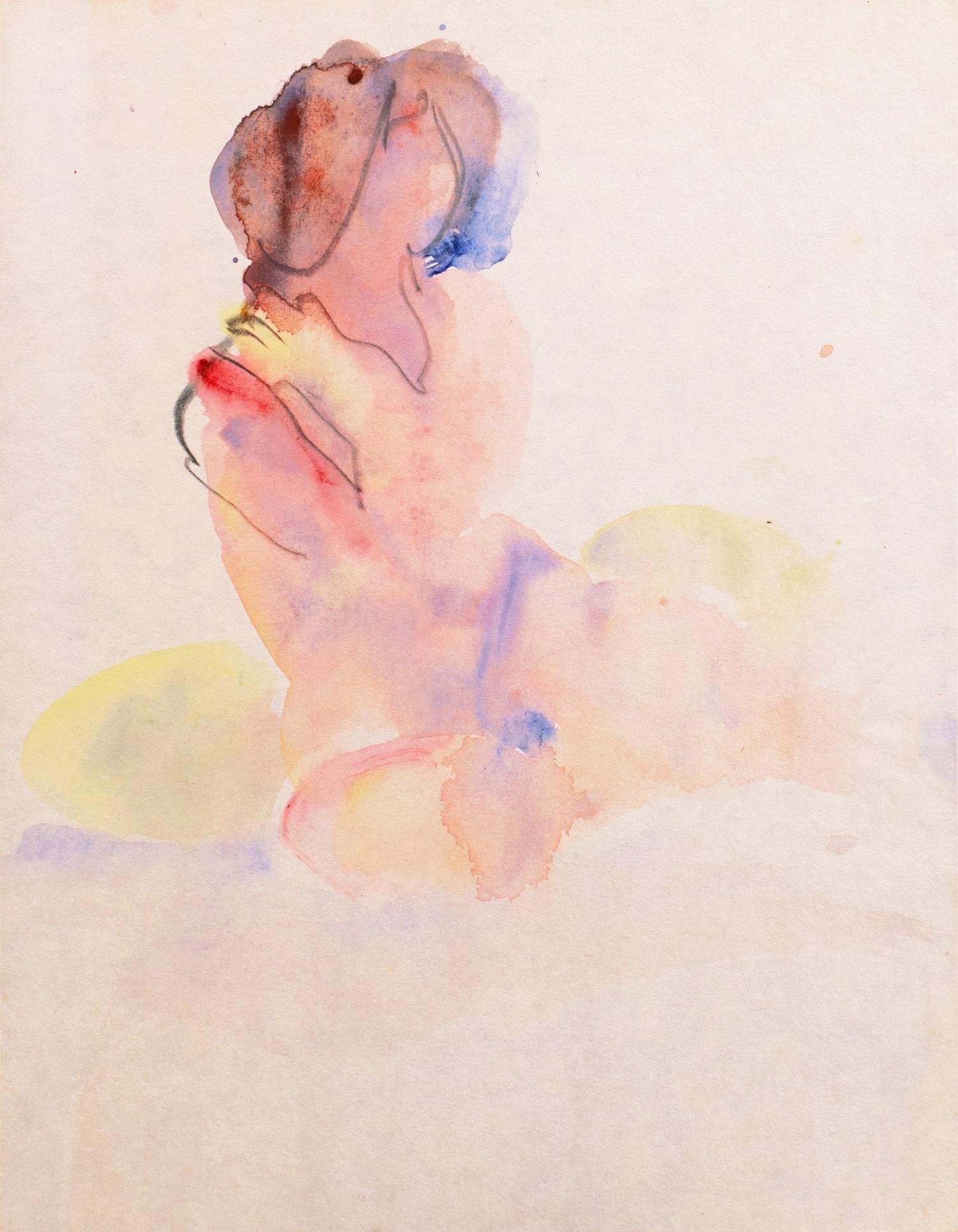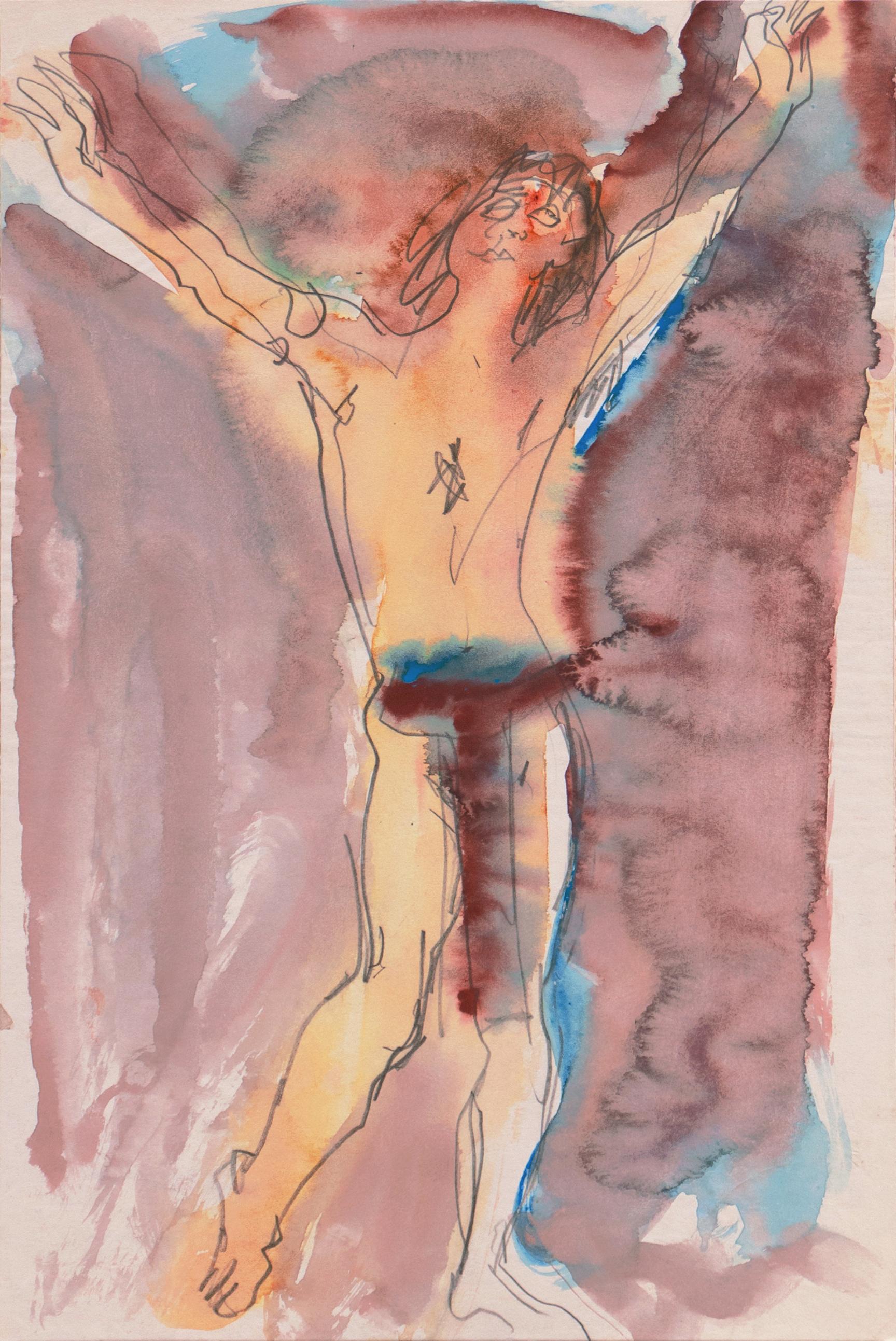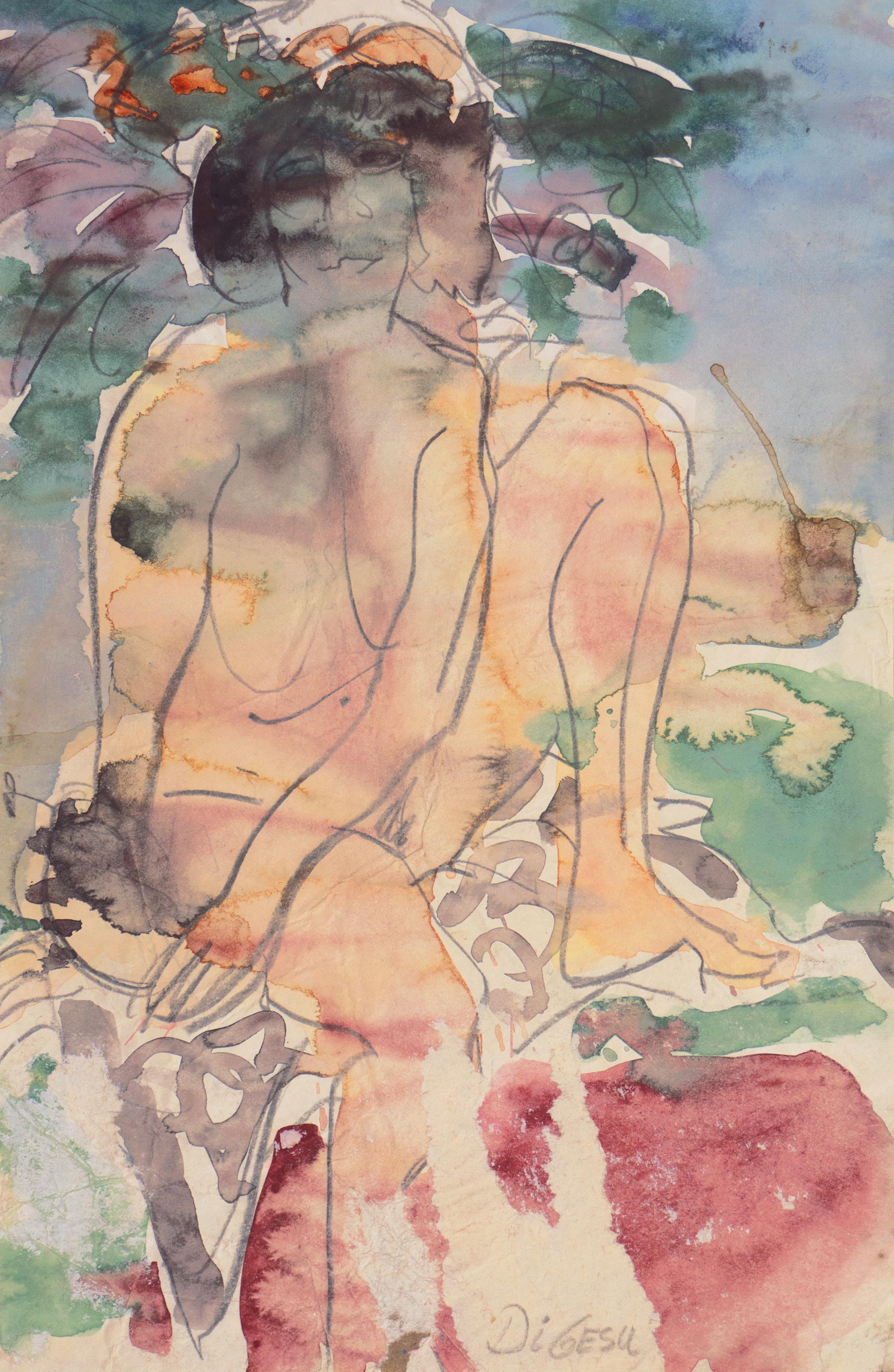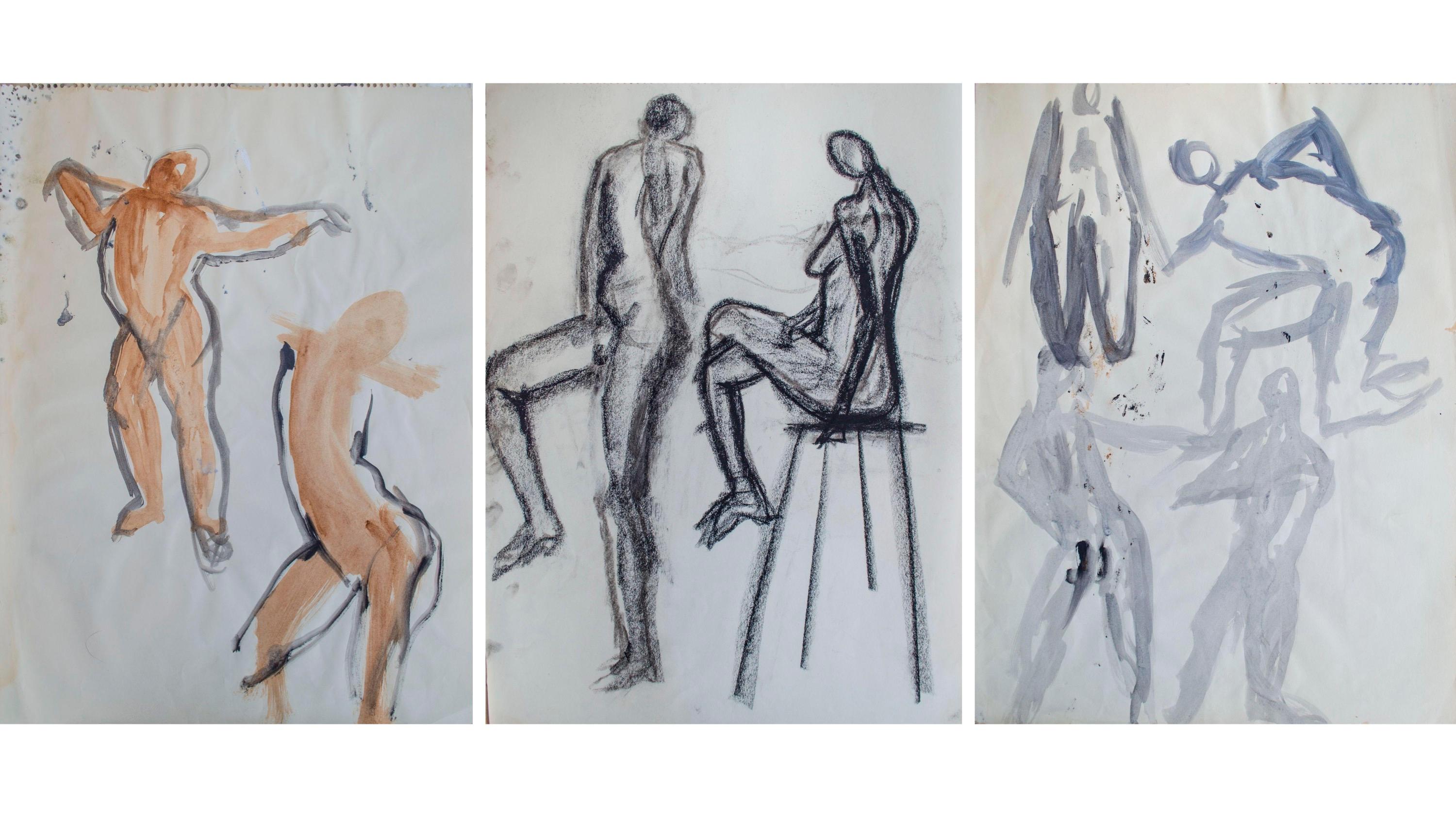Items Similar to 'Vestal Virgin', Danish Modernism, Art Deco Figural, Mythological, Neo-classical
Want more images or videos?
Request additional images or videos from the seller
1 of 14
Franz Sedivy II'Vestal Virgin', Danish Modernism, Art Deco Figural, Mythological, Neo-classical1959
1959
About the Item
Signed lower left, 'F. Sedivy' for Franz Sedivy II (Danish, 1888-1973) and dated 1959.
A dramatic figural painting of a young woman, shown naked and holding aloft an earthenware oil lamp while shielding herself modestly with a draped cloth. In the foreground, a stylized pumpkin and a breaking wave occupy the right corner while, in the background, circular design motifs repeat and echo each other, accentuating the artist's Art Deco treatment of his classical, mythological subject.
Born to an artistic family, Franz Sedivy II studied with his father, Franz Sedivy I, the Hungarian watercolorist and poster-designer. He first attended the Frederiksberg Technical School (1905-9) and the Copenhagen Technical School (1908-9) where he studied under Holger Grønvold. He subsequently attended the School of Danish Crafts (1913) where he studied with Jens Møller-Jensen. Also in 1913, he was awarded a scholarship from the Ronges Foundation. Over the next sixty years, Sedivy established his reputation as an independent artist, exhibiting widely and with success, including in Copenhagen (1919), Stockholm and Oslo (1920), Berlin (1928) and Paris (1930). In addition to his work as a fine artist, he was also much in demand as a painter and designer of theatrical and stage sets and. from 1934-1948, worked as a fine art restorer for the Danish National Museum. Franz Sedivy is listed in the Vollmer supplement of Thieme-Becker's definitive dictionary of 20th Century artists.
Reference:
Vollmer, Allgemeines Lexikon der Bildenden Künstler des 20. Jarhhunderts, Hans Vollmer, Deutscher Taschenbuch Verlag 1992, Vol. 4, p. 250; et al.
- Creator:Franz Sedivy II (1888 - 1973)
- Creation Year:1959
- Dimensions:Height: 14 in (35.56 cm)Width: 11.25 in (28.58 cm)
- Medium:
- Movement & Style:
- Period:
- Condition:toning, minor rippling, minor foxing; unframed; shows well.
- Gallery Location:Santa Cruz, CA
- Reference Number:1stDibs: LU3447494592
About the Seller
5.0
Platinum Seller
These expertly vetted sellers are 1stDibs' most experienced sellers and are rated highest by our customers.
Established in 1982
1stDibs seller since 2013
629 sales on 1stDibs
Typical response time: <1 hour
- ShippingRetrieving quote...Ships From: Santa Cruz, CA
- Return PolicyA return for this item may be initiated within 3 days of delivery.
More From This SellerView All
- 'The Artist in her Studio', Paris, Académie de la Grande Chaumière, GenevaLocated in Santa Cruz, CASigned lower left, 'Marguerite Bordet' (French, 1909-2014) and painted circa 1965. From an early age, Marguerite Bordet avidly pursued both drawing and painting. In the late 1930's and early '40s, she attended the Académie de la Grande Chaumière in Paris where she studied with the sculptor, Antoniucci Volti (Italian, 1915-1989). After several years, and feeling increasingly disconnected with the academic atmosphere of the Salon, she left to develop her independent artistic style. Bordet's first public exhibition took place at the Galerie Claude (1947) and, for the next forty years, she continued to exhibit widely with success, both throughout France and internationally, including in Cairo (1955), Geneva (1960) and the United States (1966). A 1962 exhibition of her work showed a thematic rejection of the Academy's influence and the artist's shift to a more personal and spiritually driven style. Bordet continued to take frequent study trips to Italy, especially to Florence, where she was inspired by the Renaissance Masters. She also visited England (1975-76) where the works of J.M.W.Turner and John Martin at the Tate Museum had a pronounced impact on her development. In an interview with Hervé Serane, Marguerite Bordet described her artistic process in these words: "I start my painting with spots. Sometimes I cover it completely and everything is dark. But then it's stronger than me, I can't bear that there isn't an opening. Immediately, I place a Light. I need the shadow to bring out the Light. So I start with the shadow to create this Light. I cannot define why I need this Light so much. It's stronger than me. It's something that dominates me without my being able to explain it intellectually. It is for me an absolute necessity to seek the Light in the darkness.. You have to open like you open a window. You have to reveal. I remove the stains that obscure my painting to find the luminous background of the canvas.... I only paint with transparent colors and I apply several layers of glaze to preserve this light." Partial Exhibition Record: 1947 Paris, Galerie Claude 1951 Paris, Galerie Breteau - Cairo, Galerie Adam - Alexandria, l'Atelier 1954 Paris, Galerie Simone Bdinier 1955 Cairo, l'Atelier 1959 Paris, Galerie A. Weil 1960 Geneva, Galerie Motte 1962 Paris, Marignan Gallery 1964 Paris, Ror Volmar Gallery 1966 San Rafael (U.SA) International Museum 1966 Cagnes-sur-Mer, Castle Gallery...Category
1960s Figurative Drawings and Watercolors
MaterialsPaper, Gouache, Graphite
- 'Seated Nude', Paris, Louvre, Salon d'Automne, Académie Chaumière, SFAA, LACMABy Victor Di GesuLocated in Santa Cruz, CAEstate stamp, verso, for Victor Di Gesu (American, 1914-1988) and painted circa 1955. Winner of the Prix Othon Friesz, Victor di Gesu first attended the Los Angeles Art Center and t...Category
1950s Post-Impressionist Nude Drawings and Watercolors
MaterialsGraphite, Watercolor, Gouache, Paper
- 'Man Stretching', Paris, Louvre, Académie Chaumière et Etrangères, LACMA, SFAABy Victor Di GesuLocated in Santa Cruz, CAStamped, verso, with estate stamp for Victor Di Gesu (American, 1914-1988) and created circa 1950. Winner of the Prix Othon Friesz, Victor di Gesu first attended the Los Angeles Art...Category
1950s Post-Impressionist Figurative Drawings and Watercolors
MaterialsGraphite, Gouache, Paper
- 'Seated Nude' Paris, Louvre, Salon d'Automne, Académie Chaumière, LACMA, SFAABy Victor Di GesuLocated in Santa Cruz, CAPainted by Victor Di Gesu (American, 1914-1988) circa 1955 and stamped, verso, with Victor di Gesu estate stamp. A haunting and atmospheric figural watercolor showing a young woman ...Category
1950s Post-Impressionist Nude Drawings and Watercolors
MaterialsWatercolor, Paper, Gouache, Graphite
- 'Seated Nude', Musee d'Art Moderne, Paris, SFAA, LACMA, California Woman ArtistBy Janet Ament De La RocheLocated in Santa Cruz, CAStamped, verso, with certification of authenticity for Jane Ament De La Roche (American, 1916-2000) and created circa 1950. Winner of the Prix Othon Friesz, Ament first studied at the Chouinard Art Institute and, subsequently, in Paris with André L’Hote...Category
1950s Post-Impressionist Nude Drawings and Watercolors
MaterialsPaper, Graphite, Watercolor
- 'Nude', Musee d'Art Moderne, Paris, SFAA, LACMA, California Woman Artist, CarmelBy Janet Ament De La RocheLocated in Santa Cruz, CAStamped, verso, with certification of authenticity for Jane Ament De La Roche (American, 1916-2000) and created circa 1950. Winner of the Prix Othon Friesz, Ament first studied at the Chouinard Art Institute and, subsequently, in Paris with André L’Hote...Category
1950s Post-Impressionist Nude Drawings and Watercolors
MaterialsPaper, Graphite, Watercolor
You May Also Like
- "The Dance, " Ludovico Lipparini, graphite, gouache, mythological, classicalLocated in Wiscasset, ME"The Dance" by Ludovico Lipparini is a beautifully rendered work on paper in the classical tradition using graphite and gouache and created in the f...Category
Early 19th Century Realist Figurative Drawings and Watercolors
MaterialsGouache, Paper, Graphite
- Group of 3 Figure Drawings by Attributed to Ross BlecknerBy Ross BlecknerLocated in Larchmont, NYAttributed to Ross Bleckner (American, b. 1949) Group of 3 Double Sided Drawings Watercolor and graphite on paper All approx. 24 x 18 in. Ross Bleckner grew up in Hewlett, Long Island, New York; drawing all the time without being aware that other artists existed. He was the middle child between two sisters; his father manufactures electronic parts He attended New York University where Sol Lewitt, Chuck Close and others were his teachers. He graduated in 1972, then spent a year at the California Institute of Arts. His contacts in the next few years were very fortuitous; Sol Lewitt and Chuck Close, Carl Andre, David Salle, Julian Schnabel, etc. Bleckner is on the nervous side, beset by self-doubt, insomnia, and gloom. He is unpretentious, although he is bluntly handsome, with olive complexion, and a compact build. He is "10 percent that is superficial and 90 percent that has to do with the depths and that is threatened by living. He is a very complicated individual. He is a very, very morose, deeply feeling, hardworking artist- he takes a lot from within himself - but always, no matter how successful he is, he feels he is going to fall into those depths." 1 Bleckner first exhibited his work in New York in 1974. The following year he was given his first one-man show; he was included in the 1975 Whitney Biennial.. Since about 1985 has addressed many of his paintings to the subject of AIDS- both documenting it as a historical phenomenon and commemorating specific individuals who have died. Written and submitted by Jean Ershler Schatz, artist and researcher from Laguna Woods, California. Bio sourced from the Archives of askArt. Sources include: Ross Bleckner's Mood Indigo by Lisa Liebmann, in ARTnews, May 1993...Category
Late 20th Century Contemporary Figurative Drawings and Watercolors
MaterialsPaper, Watercolor, Graphite
- Group of 3 Double Sided Figure Drawings by Ross Bleckner (attrb.)By Ross BlecknerLocated in Larchmont, NYAttributed to Ross Bleckner (American, b. 1949) Group of 3 Double Sided Drawings Ink and graphite on paper Largest: 23 1/2 x 17 1/4 in. Smallest: 22 7/8 x 18 in. Ross Bleckner grew up in Hewlett, Long Island, New York; drawing all the time without being aware that other artists existed. He was the middle child between two sisters; his father manufactures electronic parts He attended New York University where Sol Lewitt, Chuck Close and others were his teachers. He graduated in 1972, then spent a year at the California Institute of Arts. His contacts in the next few years were very fortuitous; Sol Lewitt and Chuck Close, Carl Andre, David Salle, Julian Schnabel, etc. Bleckner is on the nervous side, beset by self-doubt, insomnia, and gloom. He is unpretentious, although he is bluntly handsome, with olive complexion, and a compact build. He is "10 percent that is superficial and 90 percent that has to do with the depths and that is threatened by living. He is a very complicated individual. He is a very, very morose, deeply feeling, hardworking artist- he takes a lot from within himself - but always, no matter how successful he is, he feels he is going to fall into those depths." 1 Bleckner first exhibited his work in New York in 1974. The following year he was given his first one-man show; he was included in the 1975 Whitney Biennial.. Since about 1985 has addressed many of his paintings to the subject of AIDS- both documenting it as a historical phenomenon and commemorating specific individuals who have died. Written and submitted by Jean Ershler Schatz, artist and researcher from Laguna Woods, California. Bio sourced from the Archives of askArt. Sources include: Ross Bleckner's Mood Indigo by Lisa Liebmann, in ARTnews, May 1993...Category
Late 20th Century Contemporary Figurative Drawings and Watercolors
MaterialsPaper, Watercolor, Graphite
- Group of 3 Figure Drawings by Ross Bleckner (attrb.)By Ross BlecknerLocated in Larchmont, NYAttributed to Ross Bleckner (American, b. 1949) Group of 3 Double Sided Drawings Watercolor and graphite on paper Largest: 24 x 18 in. Smallest: 23 1/4 x 18 in. Ross Bleckner grew up in Hewlett, Long Island, New York; drawing all the time without being aware that other artists existed. He was the middle child between two sisters; his father manufactures electronic parts He attended New York University where Sol Lewitt, Chuck Close and others were his teachers. He graduated in 1972, then spent a year at the California Institute of Arts. His contacts in the next few years were very fortuitous; Sol Lewitt and Chuck Close, Carl Andre, David Salle, Julian Schnabel, etc. Bleckner is on the nervous side, beset by self-doubt, insomnia, and gloom. He is unpretentious, although he is bluntly handsome, with olive complexion, and a compact build. He is "10 percent that is superficial and 90 percent that has to do with the depths and that is threatened by living. He is a very complicated individual. He is a very, very morose, deeply feeling, hardworking artist- he takes a lot from within himself - but always, no matter how successful he is, he feels he is going to fall into those depths." 1 Bleckner first exhibited his work in New York in 1974. The following year he was given his first one-man show; he was included in the 1975 Whitney Biennial.. Since about 1985 has addressed many of his paintings to the subject of AIDS- both documenting it as a historical phenomenon and commemorating specific individuals who have died. Written and submitted by Jean Ershler Schatz, artist and researcher from Laguna Woods, California. Bio sourced from the Archives of askArt. Sources include: Ross Bleckner's Mood Indigo by Lisa Liebmann, in ARTnews, May 1993...Category
Late 20th Century Contemporary Figurative Drawings and Watercolors
MaterialsPaper, Watercolor, Graphite
- Ross Bleckner Group of 3 Double Sided Figure Drawings (attrb.)By Ross BlecknerLocated in Larchmont, NYAttributed to: Ross Bleckner (American, b. 1949) Group of 3 Double Sided Drawings Watercolor and graphite on paper Largest: 24 x 18 in. Smallest: 23 1/4 x 18 in. Ross Bleckner grew up in Hewlett, Long Island, New York; drawing all the time without being aware that other artists existed. He was the middle child between two sisters; his father manufactures electronic parts He attended New York University where Sol Lewitt, Chuck Close and others were his teachers. He graduated in 1972, then spent a year at the California Institute of Arts. His contacts in the next few years were very fortuitous; Sol Lewitt and Chuck Close, Carl Andre, David Salle, Julian Schnabel, etc. Bleckner is on the nervous side, beset by self-doubt, insomnia, and gloom. He is unpretentious, although he is bluntly handsome, with olive complexion, and a compact build. He is "10 percent that is superficial and 90 percent that has to do with the depths and that is threatened by living. He is a very complicated individual. He is a very, very morose, deeply feeling, hardworking artist- he takes a lot from within himself - but always, no matter how successful he is, he feels he is going to fall into those depths." 1 Bleckner first exhibited his work in New York in 1974. The following year he was given his first one-man show; he was included in the 1975 Whitney Biennial.. Since about 1985 has addressed many of his paintings to the subject of AIDS- both documenting it as a historical phenomenon and commemorating specific individuals who have died. Written and submitted by Jean Ershler Schatz, artist and researcher from Laguna Woods, California. Bio sourced from the Archives of askArt. Sources include: Ross Bleckner's Mood Indigo by Lisa Liebmann, in ARTnews, May 1993...Category
Late 20th Century Contemporary Figurative Drawings and Watercolors
MaterialsPaper, Watercolor, Graphite
- Ross Bleckner Group of 3 Figure Drawings (attrb.)By Ross BlecknerLocated in Larchmont, NYAttributed to Ross Bleckner (American, b. 1949) Group of 3 Double Sided Drawings Watercolor and graphite on paper Largest: 24 x 18 in. Smallest: 22 3/4 x 18 in. Ross Bleckner grew up in Hewlett, Long Island, New York; drawing all the time without being aware that other artists existed. He was the middle child between two sisters; his father manufactures electronic parts He attended New York University where Sol Lewitt, Chuck Close and others were his teachers. He graduated in 1972, then spent a year at the California Institute of Arts. His contacts in the next few years were very fortuitous; Sol Lewitt and Chuck Close, Carl Andre, David Salle, Julian Schnabel, etc. Bleckner is on the nervous side, beset by self-doubt, insomnia, and gloom. He is unpretentious, although he is bluntly handsome, with olive complexion, and a compact build. He is "10 percent that is superficial and 90 percent that has to do with the depths and that is threatened by living. He is a very complicated individual. He is a very, very morose, deeply feeling, hardworking artist- he takes a lot from within himself - but always, no matter how successful he is, he feels he is going to fall into those depths." 1 Bleckner first exhibited his work in New York in 1974. The following year he was given his first one-man show; he was included in the 1975 Whitney Biennial.. Since about 1985 has addressed many of his paintings to the subject of AIDS- both documenting it as a historical phenomenon and commemorating specific individuals who have died. Written and submitted by Jean Ershler Schatz, artist and researcher from Laguna Woods, California. Bio sourced from the Archives of askArt. Sources include: Ross Bleckner's Mood Indigo by Lisa Liebmann, in ARTnews, May 1993...Category
Late 20th Century Contemporary Figurative Drawings and Watercolors
MaterialsWatercolor, Graphite, Paper





